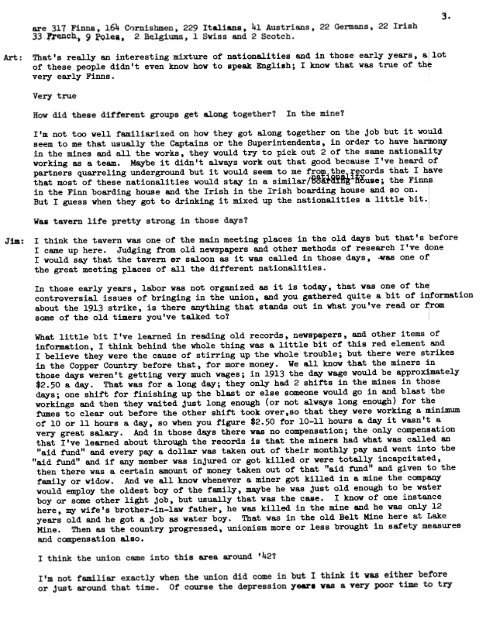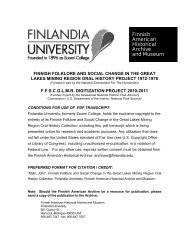Finnish American Historical Archive and Museum - Kentsgenealogy ...
Finnish American Historical Archive and Museum - Kentsgenealogy ...
Finnish American Historical Archive and Museum - Kentsgenealogy ...
Create successful ePaper yourself
Turn your PDF publications into a flip-book with our unique Google optimized e-Paper software.
are 317 Finns, 164 Cr>rnishmen, 229 Italians. 41 Austrians, 22 Germans, 22 Irish<br />
33.french., 9 ~lea, 2. Belgi~a, 1 Swiss <strong>and</strong> 2 Scotch.<br />
3.<br />
Art:<br />
That's really an interesting mixture of nationalities <strong>and</strong> in those early years, allot<br />
of these people didn't even know how to speak English; I know that was true of th~<br />
very early Finns.<br />
Very true<br />
How did these different groups get along together?<br />
In the mine?<br />
I'm not too well familiarized on how they got along together on the Job but it would<br />
seem to me that usually the Captains or the Superintendents, in order to have harmony<br />
in the mines <strong>and</strong> all the works, they would try to pick out 2 of the same national~ ty<br />
working as a team. Maybe it didn't always work out that good because I've heard Of<br />
partners quarreling un~erground but it would. seem ~o.me fro!!.; thh~~cords that ~ h~ve<br />
that most of these nat10nalities would stay 1n a s1m1lar/tia~Rfng1ff~uBe; the F1nn~<br />
in the Finn boarding house <strong>and</strong> the Irish in the Irish boarding house <strong>and</strong> so on. !<br />
But I guess when they got to drinking it mixed up the nationalities a little bit.!<br />
Was tavern life pretty strong in those days?<br />
Jim:<br />
I think the tavern was one of the main meeting places in the old days but that's before<br />
I came up here. Judging from old newspapers <strong>and</strong> other methods of research I've done<br />
I would say that the tavern er saloon as it was called in those days s 1ras one of<br />
the great meeting places of all the different nationalities.<br />
In those early years, labor was not organized as it is today, that was one of th~<br />
controversial issues of bringing in the union, <strong>and</strong> you gathered quite a bit of iri!ormation<br />
about the 1913 strike, is there anything that st<strong>and</strong>s out in what you've read or ~ram<br />
some of the old timers you've talked to? :<br />
i<br />
What little bit Ilve learned in reading old records s newspapers s <strong>and</strong> other items of<br />
info~ations I think behind the Whole thing was a little bit of this red element <strong>and</strong><br />
I believe they were the cause of stirring up the whole trouble; but there were s~rikes<br />
in the Copper Country before that s for more money. We all know that the miners in<br />
those days weren't getting very much wages; in 1913 the day wage would be approxi,mately<br />
$2.50 a day. That was for a long day; they only had 2 shifts in the mines in th~se<br />
the<br />
days; one shift for finishing up the blast or else someone would go in <strong>and</strong> blast<br />
workings <strong>and</strong> then they waited Just long enough (or not ~ways long enough) for t~e<br />
fumes to clear out be~ore the other shift took oversso that they were working a $inimum<br />
of 10 or 11 hours a day s so when you figure $2. 50 ~or 10-11 hours a day it wasn't a<br />
very great s~ary. And in those days there was no compensation; the only compen$ation<br />
that I've learned about through the records is that the miners had what was call,d an<br />
"aid fund" <strong>and</strong> every pay a dollar was taken out of their monthly pay <strong>and</strong> went int-o the<br />
"aid fund" <strong>and</strong> if any member was injured or got killed or were totally incapcitateds<br />
then there was a certain amount of money taken out of that "aid fund" <strong>and</strong> given to the<br />
family or widow. And we all know whenever a miner got killed in a mine the comp~<br />
would employ the oldest boy o~ the ~amily s maybe he was Just old enough to be water<br />
boy or some other light Job s but usually that was the case. I know of one instance<br />
here s my wife's brother-in-law father s he was killed in the mine <strong>and</strong> he was only 12<br />
years old <strong>and</strong> he got a Job as water boy. That was in the old Belt Mine here at take<br />
Mine. Then as the country progressed s unionism more or less brought in safety measures<br />
<strong>and</strong> compensation also.<br />
I think the union came into this area around' 421<br />
11m not familiar exactly when the union did come in but I think it was either before<br />
or just around that time. Of course the depression )"ear' vas & very poor time tp try






